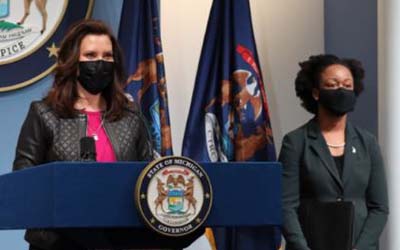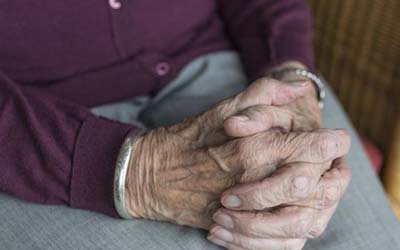
MDHHS Expands Capacity at Outdoor Stadiums and Arenas
MDHHS Expands Capacity at Outdoor Stadiums and Arenas and Increases Testing to Protect Youth in Sports
Fully vaccinated individuals may gather at residences without masks per CDC
FOR IMMEDIATE RELEASE
March 19, 2021
Contact: Lynn Sutfin, 517-241-2112
LANSING, MICH. Today, the Michigan Department of Health and Human Services (MDHHS) updated its Gatherings and Mask epidemic order, allowing up to 20% capacity in outdoor stadiums and arenas that establish infection control plans. The update also increases testing for youth ages 13-19 to ensure athletes can safely participate in sports. The changes are designed to balance day-to-day activities while controlling the spread of COVID-19 and saving Michiganders’ lives. Although progress has been made, it is crucial that Michiganders continue to mask up and socially distance as we take steps to get back to normal. The changes to the Order go into effect Monday, March 22, and remain in effect through Monday, April 19.
“The pandemic has been hard on all of us, but by staying focused on acting quickly, following the science, and listening to experts, we can save lives and help our economy recover faster,” said Gov. Gretchen Whitmer. “Today’s action is an important step towards normalcy, but there’s still more work to do. As always, mask up, maintain social distancing and wash your hands. We all have a personal responsibility to slow the spread of the virus so we can end this pandemic together. By April 5, all Michiganders will be eligible for the safe and effective COVID-19 vaccine. The vaccine is the most effective way to protect you and your family from the virus, and I urge all Michiganders to get vaccinated as soon as it’s available to you.”
“More than 3.2 million doses of the safe and effective COVID vaccines have been administered in Michigan, and we are well on our way to vaccinating 70% of Michiganders ages 16 and up,” said Dr. Joneigh Khaldun, chief medical executive and chief deputy for health at MDHHS. “While we are still very much fighting this pandemic and seeing concerning trends in new cases and hospitalizations, we are making these incremental steps that align with CDC guidance. We are again at a pivotal moment in our fight against COVID-19. Michiganders must continue doing what works to slow the spread of the disease by wearing a mask, washing their hands, avoiding crowds and making a plan to get the safe and effective COVID-19 vaccine as soon as they can.”
Gatherings at outdoor stadiums and arenas are increased to 20% of the venue’s capacity if the site:
- Establishes an infection control plan that complies with the protocols included in MDHHS’s document entitled Enhanced Outdoor Stadium and Arena Guidance.
- Posts the mitigation plan publicly.
- Sends infection control plans to the local health department and MDHHS at least seven days before scheduled events.
- Administers a testing program as specified in MDHHS’s Guidance for Athletics for all players.
“We truly appreciate the ongoing partnership with the Governor’s office and the Michigan Department of Health and Human Services. We are thrilled to safely welcome back the best fans in baseball to Comerica Park for Opening Day and beyond,” said Chris Granger, Group President, Sports and Entertainment, Ilitch Holdings. “As the season progresses, we look forward to continued coordination with public health and medical experts, government officials and Major League Baseball to ensure a safe and enjoyable environment for all Detroit Tigers fans.”
“MDHHS continues to monitor the data to make decisions that allow us to return to normalcy. This includes case counts, percent positivity and hospitalizations,” said Elizabeth Hertel, MDHHS director. We are making this capacity change along with required safety protocols designed to prevent the further spread of COVID-19.”
MDHHS had been closely monitoring three metrics for stabilization or declines over the past several weeks. Michigan’s metrics have been increasing for the past few weeks. The presence of more infectious variants, such as the B 1.1.7 variant, threatens our progress in control of the epidemic and MDHHS will be monitoring data closely. In recent days:
- Positivity rate: has increased for four weeks to 6.2%. This metric is up 177% from the mid-February low but remains below the December high of 19.4%.
- Statewide case rate: This metric has increase over the past four weeks to 172.9 cases per million. The rate is up 77% from the low in mid-February but remains below peak of 737.8 cases per million on Saturday, Nov 14.
- Hospital capacity dedicated to COVID-19 is now at 4.9%. This metric peaked at 19.6% on Tuesday, Dec. 4 and is now up 25% from an end of February low.
The Order also increases weekly testing for youth athletes ages 13-19 to safely participate in sports. More information on the program is available on the Michigan.gov/Coronavirus website.
“Michigan’s students deserve to safely enjoy the fullest high school experience we can offer,” said JoLynn Clark, principal of Frankenmuth High School. “That means finding ways to provide in-person instruction along with extracurricular activities, a fundamental part of a student’s life. This past fall, educators witnessed firsthand the detrimental impacts to both instruction and student well-being that comes when we cannot find ways to safely do both. The implementation of the testing program that allowed student-athletes to complete their fall seasons provided much needed closure, and we at Frankenmuth High School benefitted from this program. It allowed us to not only finish the fall season, but also provided opportunities for student-athletes in winter sports. Rapid antigen testing has served as an effective mitigation strategy that protects in-person instructional time and allows students extracurricular opportunities. We know we must remain vigilant in our efforts to mitigate the spread of this virus in schools as we look ahead to and are encouraged by the possibilities for in-person instruction, extra-curricular activities, and end-of-year celebrations.”
And, to ensure consistency with recently issued CDC guidance, fully vaccinated individuals may now participate in residential gatherings with other fully vaccinated individuals without wearing a mask.
Information around this outbreak is changing rapidly. The latest information is available at Michigan.gov/Coronavirus and CDC.gov/Coronavirus. To learn more about the COVID-19 vaccine, visit Michigan.gov/COVIDVaccine.







